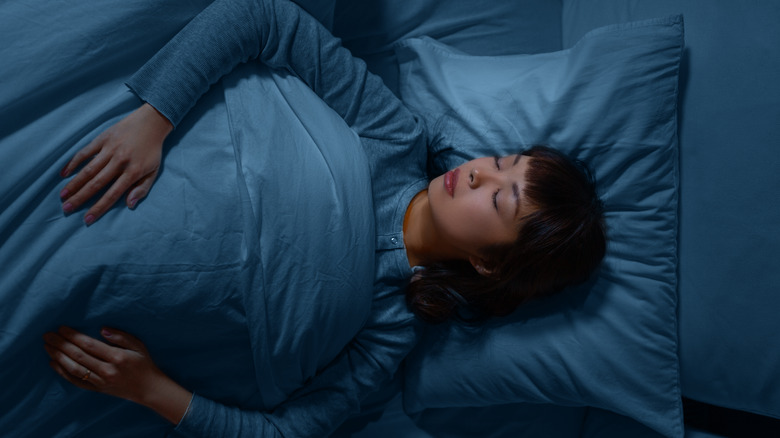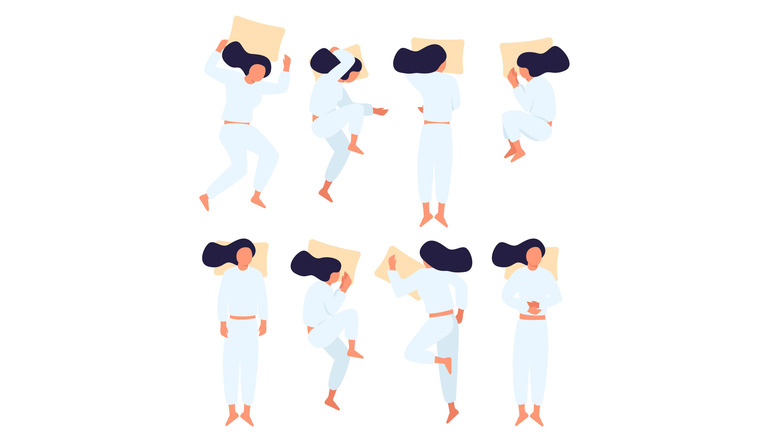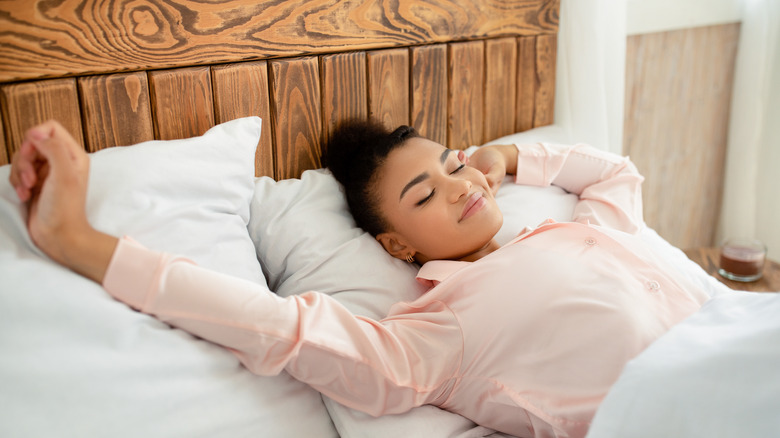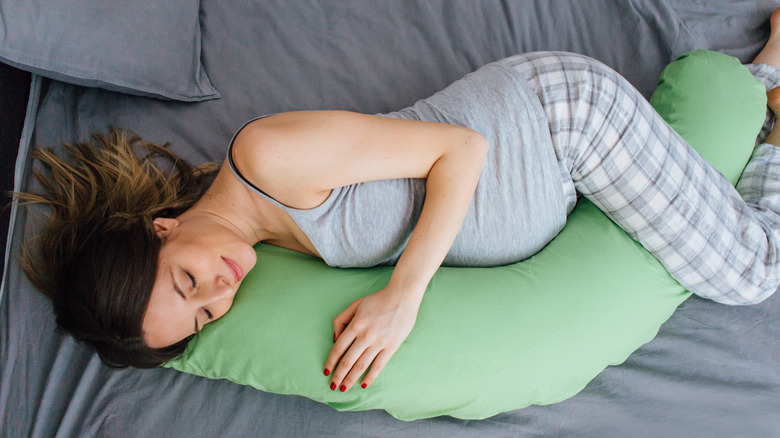Tips For Training Your Body To Sleep In A Different Position For More Restful Sleep
You may have heard before that your sleeping position is related to your personality. In 2003, sleep scientist Chris Idzikowski studied 1,000 people and their sleeping habits. His findings, published in a BBC News article, suggested that your go-to position predicts how extroverted you are, how you make decisions, and how you respond to stress.
While Idzikowski's assumptions may or may not be accurate (Healthline points out flaws in the research), your sleeping position does matter, at least for your health. "It's important that people take time to think about how they position themselves when they sleep," Peggy Brill, an orthopedic physical therapist, told The Wall Street Journal. "Rest is important for the muscular-skeletal system to recover. [...] The proteins get back into the muscles, there's rejuvenation of the body, so you want to be in a healthy anatomical position when you sleep."
However, there's a good chance you're not always snoozing in an optimal position. A 2004 study published in The Internet Journal of Allied Health Sciences and Practice noted that most people move their bodies between three and 36 times per night and our preferred sleep posture is determined in infancy. However, that doesn't mean you can't learn to sleep in a new position in adulthood. Here's how you should be sleeping — and how to train your body to do it.
The best sleeping position for your body
Some experts tout the benefits of sleeping on your back or recommend only lying on your side, but really, the ideal position depends on a variety of factors. If sleep apnea and snoring are interrupting your ZZZs, Healthline suggests sleeping on your side. A side position is also ideal during pregnancy and for those who have acid reflux (stick with the left side for relief). However, sleeping on your back is generally considered the optimal position for spine, hip, and knee support. With a comfy mattress and sturdy pillow, back sleeping may relieve pain, as well as help with sinus congestion — two ailments that can easily ruin your rest.
If you're already snoozing soundly at night but worried about aging your skin, you might also want to rethink your current sleeping position, especially if you rest on your side or stomach. "Sleeping preferentially on one side of your face, or on your stomach, can lead to pressure and shear forces on the skin, along with creasing of the skin," Courtney Rubin, a dermatologist, and co-founder of skincare brand Fig.1, told HuffPost. To prevent wrinkles, sleep on your back instead.
Keep in mind that not everyone's anatomy is exactly the same. You might have a shoulder injury that prevents you from sleeping comfortably on one side, for example, or a condition like scoliosis may make back sleeping painful. Listen to your body to determine which position is most comfortable.
How to train yourself to sleep on your back
Back sleeping may be best for you if you need a little extra support, but that doesn't mean your body will naturally choose that position throughout the night. In fact, most adults prefer to sleep on their sides, according to The Sleep Doctor. To train yourself to sleep on your back, start with a good pillow. Look for a pillow that comfortably cradles the neck, like a memory foam or rounded type. That may help your head stay in place and stop you from tossing and turning. You can also place longer body pillows along your left and right sides to create barriers until sleeping on your back becomes second nature.
Don't assume that back sleeping means you have to lie long and flat like a board. Adjusting your legs can be the key to finding a comfortable position. Slightly bend the knees to relieve tension in your lower back, or spread out like a starfish if you have the space. You can also place pillows (yep, pillows are your friend) under your knees and back to ease pain and maintain alignment, notes Sleep Foundation.
How to become a side sleeper
To start sleeping on your side regularly, it's crucial to amp up your physical support. Grab a pillow with a tall enough loft to keep your head, neck, and spine in a straight line — but don't stop with just one pillow. "You should have your shoulder on a flat pillow to prevent your upper body from rotating forward or backward," Colleen Louw, a physical therapist, told Real Simple. To remain sleeping on your side, also employ the help of a body pillow or your sleeping partner. Spoon your significant other or hug the body-sized pillow to stay in place throughout the night.
If you find that you tend to roll onto your back while sleeping, try the tennis ball technique. The method involves securing a tennis ball (such as with tape) to the back of your pajama shirt, preventing you from comfortably resting on your back. It may not be a realistic long-term solution, but it can temporarily help train your body to rest in a different position.
What's wrong with sleeping on your stomach?
Stomach sleeping may be preferable for some people and can even be an option for those struggling with sleep apnea and chronic snoring, but in general, experts don't recommend it for restful sleep. For one, it's a pain in the neck — literally. As chiropractor Andrew Bang told Cleveland Clinic, "Imagine standing and looking one way for two or three hours at a time. Stretching your neck muscle for that long creates soreness." Sleeping on your stomach is also awkward for your back and can cause aches and numbness.
If you can't seem to shake your stomach sleeping habit, there are a few ways to make the position a little healthier for your body. Healthline suggests using a thin pillow under the head. A thicker pillow meant for back or side sleepers may raise the head too much above the spine, creating painful tension. If you still notice discomfort, you can try sleeping without a head pillow instead.
Another solution: Place a pillow under your forehead, keeping your head facing straight down toward the mattress. Pillow brand Belly Sleep explains that this protects your neck while giving you space to breathe. Finally, place a pillow under the pelvis, especially if you notice back pain during or after sleep.




